
baseball pitcher workout pdf
The Baseball Pitcher Workout PDF is a comprehensive guide designed to enhance pitching performance through structured off-season training and the proven 3X Pitching Velocity Program.
1.1 Importance of Off-Season Training for Pitchers
Off-season training is critical for pitchers to build strength, endurance, and velocity. It allows for recovery from in-season wear and tear while enhancing leg drive and core power, essential for pitching performance. A structured off-season program helps prevent injuries, improves mechanics, and ensures pitchers are fully prepared for the demands of the upcoming season. This period is vital for gaining strength and size, as it directly translates to increased velocity and durability on the mound.
1.2 Overview of the 3X Pitching Velocity Program
The 3X Pitching Velocity Program is a scientifically designed system to boost pitching velocity through targeted strength and conditioning. It focuses on enhancing lower body power, core strength, and rotational mechanics. The program incorporates specific exercises like squats, leg curls, and planks, along with weighted ball training to maximize results. By following this structured approach, pitchers can achieve significant increases in speed and performance, making it a cornerstone of modern pitching development.

Full-Body Strength and Conditioning Routine
This program combines lower body exercises like squats and leg curls with upper body workouts, including barbell bench presses, to build overall strength and endurance for pitchers.
2.1 Lower Body Exercises
Lower body exercises are crucial for pitchers, focusing on building leg and glute strength to enhance pitching velocity. Squats, leg curls, and leg extensions are essential, targeting muscles used in leg drive. These exercises improve power and stability, directly translating to better mound performance. A typical routine includes 3 sets of 12-15 reps for squats and leg curls, ensuring proper form to prevent injury. Consistency in these workouts helps pitchers maintain endurance and explosiveness throughout the season.
2.2 Upper Body Exercises
Upper body exercises for pitchers focus on building strength and endurance in the chest, shoulders, and back. The barbell bench press is a cornerstone, with 4 sets of 12, 10, 8, and 6 reps. Incline presses and pull-ups target the upper chest and lat muscles, enhancing stability and control. These exercises improve posture, reduce injury risk, and support overall pitching mechanics. Proper form is crucial to avoid strain and maximize effectiveness in the workout routine.
2.3 Core and Rotator Cuff Strengthening
The core and rotator cuff are critical for pitchers, as they stabilize the body and generate pitching power. Exercises like planks, shoulder external rotations, and scapular push-ups are essential. Planks build abdominal stability, while rotator cuff exercises prevent injuries and improve control. These workouts enhance overall pitching mechanics and durability, ensuring long-term performance and injury prevention. They are integral to the pitcher’s strength and conditioning routine, supporting both velocity and precision on the mound.
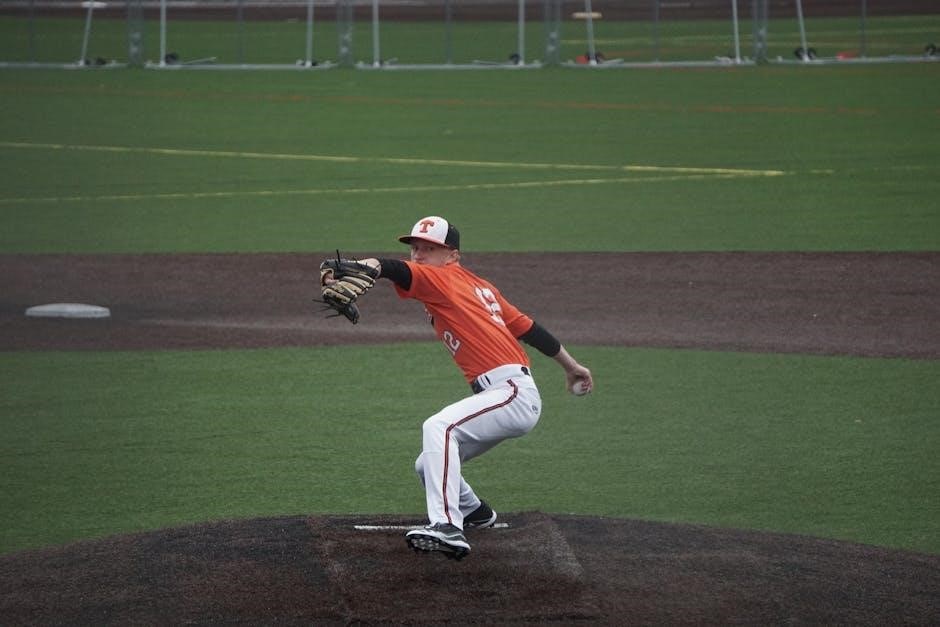
7-Day Training Program for Starting Pitchers
This structured program balances pitching, strength, and recovery, ensuring optimal performance. It includes game days, bullpen sessions, light throws, and rest to maintain peak conditioning and avoid fatigue.
3.1 Day 1: Game or Bullpen
Day 1 focuses on live game situations or bullpen sessions, emphasizing pitch execution and strategy. Pitchers throw 45-60 pitches, incorporating all pitches in their arsenal. After pitching, a light upper body workout and 10 minutes of conditioning, such as biking or jump rope, are performed to maintain endurance. This day prioritizes recovery and active techniques to ensure readiness for the next training phase without overexertion.
3.2 Day 2: Light Upper Body Workout
Day 2 involves a light upper body workout to maintain strength without overexertion. Pitchers perform exercises like push-ups, bench presses, and rows with moderate weights. The focus is on controlled movements to avoid strain. This session lasts about 45 minutes, followed by stretching to enhance flexibility and promote recovery. The goal is to preserve upper body strength while allowing the body to heal from Day 1’s pitching activities.
3.3 Day 3: Light Throw and Lower Body Workout
Day 3 combines a light throwing session with a lower body workout to maintain pitching mechanics and leg strength. Pitchers engage in short, controlled throws to keep the arm active without overexertion. The lower body routine includes exercises like squats and leg curls to build leg drive, crucial for velocity. This balanced approach ensures pitchers maintain strength and technique while allowing recovery from previous days’ efforts, keeping the body fresh for upcoming bullpen sessions.
3.4 Day 4: Rest or Active Recovery
Day 4 focuses on rest or active recovery to allow the body to heal and recharge. Pitchers can engage in low-intensity activities like yoga, light cardio, or foam rolling to promote blood flow without overexertion. This day is crucial for preventing overtraining and reducing the risk of injury. Active recovery helps maintain mobility while giving the arm and lower body time to recover from the previous days’ workouts, ensuring optimal performance in upcoming training sessions.
3.5 Day 5: Mid-Week Bullpen
Day 5 involves a mid-week bullpen session, focusing on throwing mechanics and pitch execution. Pitchers work through 45-60 pitches, incorporating all types of pitches. This session is essential for maintaining and refining pitching skills mid-week, ensuring consistency and control. It also helps in identifying and addressing any technical issues, allowing for immediate adjustments. The bullpen session is followed by a light upper body workout to maintain strength without overexerting, keeping the arm fresh for the remainder of the training week.
3.6 Day 6: Lower Body and Core Workout
Day 6 focuses on lower body and core strengthening to enhance pitching velocity and stability. Exercises like squats, leg curls, and extensions target the legs and glutes, while planks and rotational exercises improve core stability. This workout is designed to build the explosive power needed for pitching. Proper form and progression are emphasized to prevent injury and maximize results, aligning with the structured approach of the Baseball Pitcher Workout PDF.
3.7 Day 7: Rest or Active Recovery
Day 7 emphasizes rest or active recovery to allow the body to heal and adapt. Light activities such as yoga, swimming, or foam rolling are recommended to maintain flexibility without overexertion. Adequate sleep and nutrition are crucial during this phase to support muscle recovery and overall performance. This strategic rest day ensures pitchers return to training refreshed and ready to optimize their results, as outlined in the Baseball Pitcher Workout PDF.
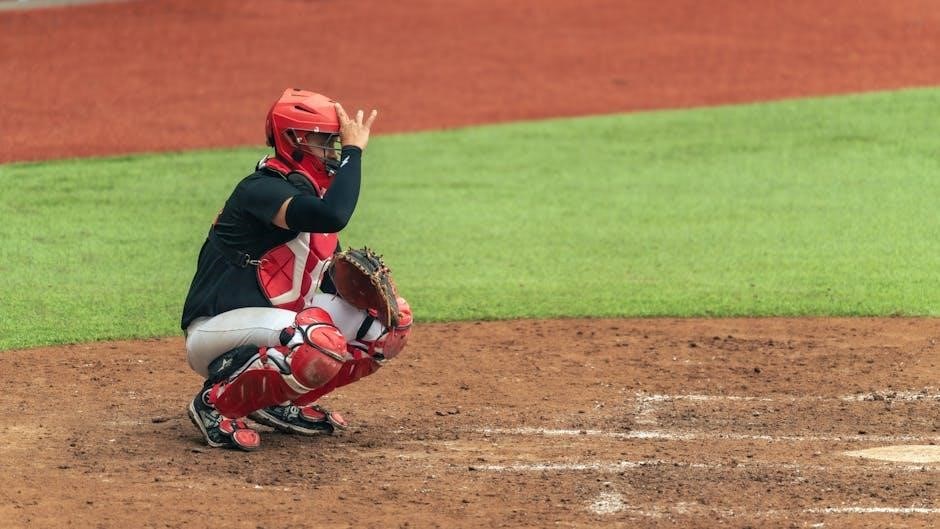
In-Season Strength Maintenance
Maintaining strength during the season is crucial for pitchers to sustain performance and prevent injury, focusing on balanced routines that avoid overtraining while preserving muscle mass.
4.1 Avoiding Common Training Mistakes

Avoiding common training mistakes is essential for maintaining strength and health during the season. Overtraining and improper exercises can lead to injuries and decreased performance. Focus on balanced routines and avoid excessive strain. Ensure proper rest and recovery to maintain peak condition and prevent muscle loss. Tailor workouts to individual needs and monitor progress to stay healthy and effective on the field throughout the season.
4.2 Maintaining Strength and Body Weight
Maintaining strength and body weight is crucial for pitchers to sustain performance throughout the season. A balanced nutrition plan and consistent training routine help preserve muscle mass. Monitor progress to avoid weight loss, which can reduce strength and endurance. Adjust workouts and diet as needed to maintain optimal physical condition, ensuring peak performance on the mound without compromising health or stamina.
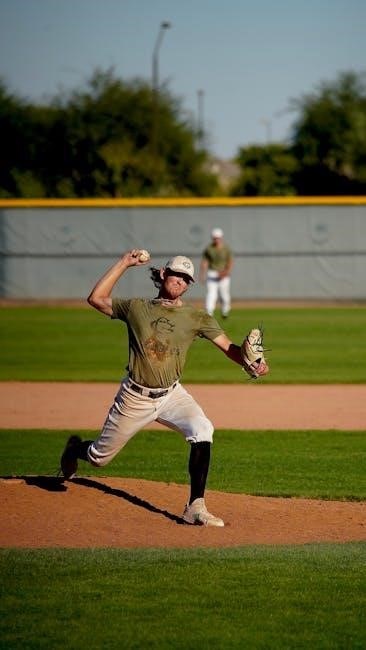
Weighted Ball Training
Weighted ball training enhances pitching velocity and strength by using balls of varying weights. It improves power and endurance when integrated into a structured program with proper technique.
5.1 Benefits of Weighted Ball Training
Weighted ball training boosts pitching velocity, enhances power, and improves control by strengthening the arms, shoulders, and core. It helps pitchers generate more force and endurance, refining mechanics. By using balls of varying weights, pitchers can adapt to different training phases, from building strength to enhancing speed. This method is versatile, allowing integration into both off-season and in-season routines, making it a valuable tool for pitchers aiming to elevate their performance and maintain consistency on the mound.
5.2 Risks and Considerations
Weighted ball training carries risks, including arm injuries if improperly implemented. Overloading can strain the shoulder and elbow, leading to injuries. A structured program with gradual progression is essential to minimize risks. Proper warm-up, technique, and recovery are crucial. Coaches should monitor workload and ensure pitchers avoid overtraining. Balancing weighted ball drills with traditional throwing is key to maintaining arm health and preventing fatigue, ensuring long-term effectiveness and safety for pitchers.
Lower Body Exercises for Pitching Velocity
Lower body exercises like squats, leg curls, and leg extensions are essential for generating power, stability, and endurance, directly enhancing pitching velocity and overall performance.
6.1 Squats
Squats are a foundational exercise for pitchers, targeting the legs, hips, and core. They improve strength, power, and stability, which are critical for generating velocity. Perform 3 sets of 12-10-10 reps, focusing on proper form to avoid injury. Keep your back straight, engage your core, and lower until your thighs are parallel to the ground. This exercise enhances leg drive, a key component of pitching mechanics, helping you deliver pitches with more force and precision.
6.2 Leg Curls and Leg Extensions
Leg curls and leg extensions are essential for targeting the hamstrings and quadriceps, crucial for pitching power and stability. Perform 3 sets of 15-12-12 reps for each exercise. Leg curls focus on hamstring strength, improving acceleration and stability, while leg extensions enhance quadriceps power, aiding in explosive drive. Proper form is critical to avoid injury. These exercises complement squats, ensuring balanced lower body development and maximizing pitching velocity through enhanced leg and hip mechanics.
Warm-Up and Stretching Routine
A proper warm-up includes dynamic stretches to prepare joints and muscles, while static stretches improve flexibility and prevent injuries, essential for pitchers’ performance and longevity.
7.1 Dynamic Stretches
Dynamic stretches are essential for pitchers, involving active movements that mimic pitching motions. These include arm circles and leg swings to increase blood flow and reduce muscle tension. They prepare the shoulders, elbows, and hips for high-intensity throws, enhancing flexibility and range of motion. Regular dynamic stretching helps prevent injuries and improves overall performance on the mound. Incorporating these into a pre-pitching routine ensures optimal readiness and reduces the risk of strain.
7.2 Static Stretches
Static stretches involve holding specific poses to lengthen muscles and improve flexibility. For pitchers, key areas include the shoulders, hamstrings, and hip flexors. These stretches are best performed post-workout when muscles are warm. Holding each stretch for 20-30 seconds enhances mobility and reduces muscle soreness. Regular static stretching helps maintain proper pitching mechanics and prevents tightness that can lead to injury. Incorporating these stretches into a daily routine supports long-term flexibility and overall pitching performance.
7.3 Examples of Stretching Exercises
Key stretching exercises for pitchers include shoulder external rotations, chest opens, and hamstring stretches. These exercises target areas critical for pitching mechanics. Shoulder rotations improve range of motion, while chest opens enhance posture and throwing accuracy. Hamstring stretches prevent tightness that can hinder leg drive. Incorporating these exercises into a daily routine supports flexibility, reducing injury risk and improving overall performance on the mound. Consistency is essential for long-term benefits.
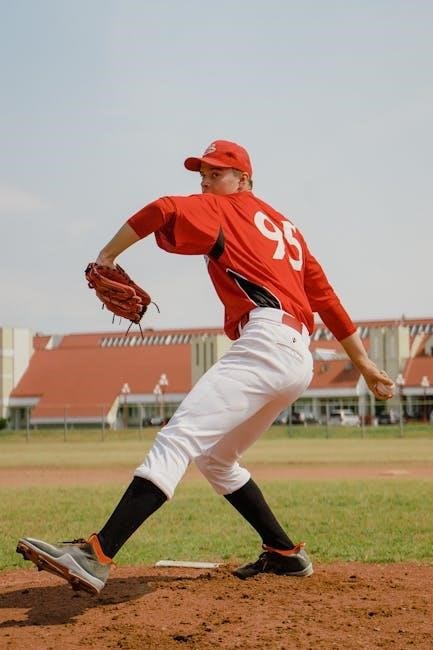
Core and Rotator Cuff Strength
Core and rotator cuff strength are essential for pitchers, enhancing stability and power. Exercises like planks, shoulder rotations, and band work improve durability and performance.
8.1 Planks
Planks are a foundational exercise for core stability, crucial for pitchers. They strengthen the abs, obliques, and lower back, enhancing posture and reducing injury risk. Pitchers should perform variations like forearm planks and side planks to target different muscle groups. Aim for 3 sets of 30-60 seconds. This exercise improves balance and overall core endurance, essential for maintaining consistent pitching mechanics throughout the game. Incorporate planks into your routine to build a stronger, more resilient core.
8.2 Rotator Cuff Exercises
Rotator cuff exercises are vital for pitchers to maintain shoulder health and prevent injuries. Focus on exercises like shoulder external rotations, internal rotations, and scapular push-ups to strengthen the muscles around the shoulder joint. These exercises improve stability, reduce the risk of strains, and enhance overall pitching mechanics. Consistency in performing these drills ensures long-term durability and peak performance on the mound.
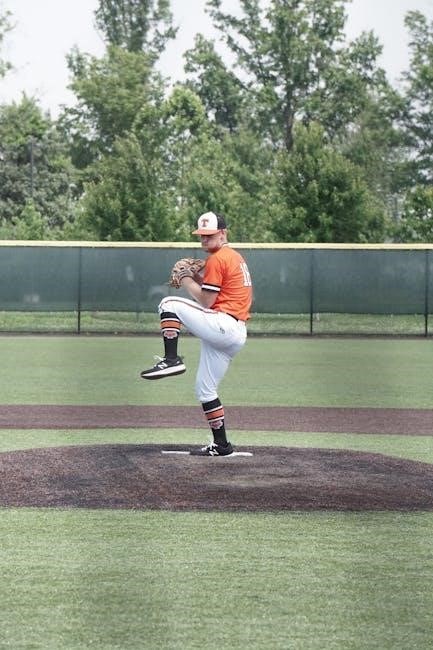
Nutrition for Pitchers
Nutrition is crucial for pitchers to fuel performance, aid recovery, and maintain strength. A balanced diet rich in proteins, carbs, and healthy fats supports energy levels and lean muscle growth.
9.1 Macronutrient Intake
A well-balanced diet for pitchers focuses on optimal macronutrient intake to support energy production, recovery, and muscle maintenance. Carbohydrates provide sustained energy for pitching sessions, while proteins aid in muscle repair and growth. Healthy fats are essential for hormonal balance and overall health. Pitchers should aim for a macronutrient breakdown of 40-50% carbs, 30-35% protein, and 20-25% fats. Proper hydration and timing of meals around workouts are also critical for performance and recovery.
9.2 Hydration Tips
Proper hydration is critical for pitchers to maintain performance and prevent fatigue. Aim to drink 8-10 glasses of water daily, increasing intake before, during, and after workouts. Avoid sugary drinks and opt for water or electrolyte-rich beverages to replenish lost salts. Monitor urine color; pale yellow indicates optimal hydration. Carry a water bottle throughout the day and set reminders to drink regularly, especially in hot climates or during intense training sessions.

Recovery Techniques
Recovery is vital for pitchers to prevent injuries and maintain performance. Techniques include ice therapy, adequate sleep, and rest days to allow the body to heal effectively.
10.1 Ice Therapy
Ice therapy is a common recovery method for pitchers to reduce muscle inflammation and soreness. Apply ice to the shoulder, elbow, or affected areas for 20 minutes post-throwing.
This practice helps minimize tissue damage and promotes healing. It’s often combined with stretching and compression for optimal recovery results, ensuring pitchers remain injury-free and perform at their best.
10.2 Sleep and Rest
Sleep and rest are critical for a pitcher’s recovery and performance. Aim for 7-9 hours of quality sleep nightly to aid muscle repair and physical rejuvenation.
Poor sleep can lead to decreased velocity, accuracy, and endurance. Prioritize a consistent sleep schedule to optimize recovery and maintain peak pitching capabilities throughout the season.

Tracking Progress
Monitor pitching velocity, strength levels, and body weight to assess improvements. Regularly track metrics to ensure the workout plan is yielding desired results and adjust as needed.
11.1 Metrics to Measure
Key metrics to track include pitching velocity, strength levels, and body weight. Measure improvements in velocity through radar gun readings. Assess strength gains via rep and weight increases. Monitor body weight to ensure proper muscle mass maintenance. Additionally, track injury recovery time and consistency in training. Use these metrics to evaluate progress and adjust the workout plan accordingly to optimize performance and achieve long-term goals effectively.
11.2 Adjusting the Workout Plan
Adjust the workout plan based on progress, injuries, or seasonal demands. Tailor exercises to address weaknesses and enhance strengths. Gradually increase intensity, volume, or recovery time as needed. For example, modify sets, reps, or weights to challenge the athlete appropriately. Regularly reassess goals and adapt the program to maintain progression and prevent plateaus. Ensure flexibility in the plan to accommodate individual needs and avoid overtraining, keeping the pitcher’s long-term performance and health as the top priority.